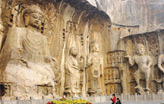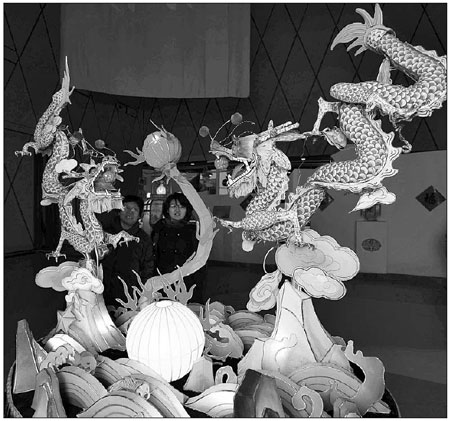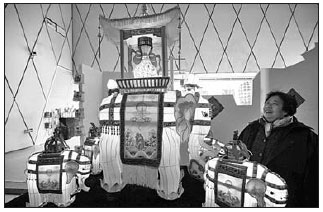Tips and Articles
Palace lanterns revived
Updated: 2011-02-13 08:25
By Li Jing (China Daily)
|
Palace lanterns, originally lit up exclusively for rulers and royalty, are now listed as intangible cultural heritage icons. Photos by Chen Xiaogen / Xinhua |
|
This lantern in the shape of a white elephant bearing a vase on its back represents jixiang ping'an, or peace and good fortune, an interplay of words and symbols. |
 |
Beijing
It's a colorful world of lanterns at the upmarket shopping enclave of Sanlitun. Li Jing picks out the best displays.
Darkness falls and it's lights up at Sanlitun Village. This Beijing fashion hub sheds its daytime sophistication and gets ready to stage another production as the cloak of night descends.
Bare trees come to life with branches outlined with twinkling snow white and rose red lights. Among them, a giant iceberg-shaped red lantern towers in the forecourt of the futurist architectural complex of Sanlitun, brightly inscribed with golden Chinese characters "Huancai Jianghu," which translates to "A colorful lantern world".
Three grandpa rabbits guard the way into the complex. Each is about two meters tall, cutting a dashing figure in an ancient general's outfit and a bright smile on his round face.
Lighted from inside, the three rabbit lanterns are mounted on high bases and protected by glass. They are bright and imposing, attracting visitors to stop and strike up poses, capturing the moment with either cell phones or cameras on tripods.
The rabbits also point the way to a magic world of lanterns in the Orange Hall of the Village.
Twenty lanterns are on exhibit here, including two dragons playing with a fireball and a pair of tigers guarding the entrance. Unlike normal lanterns, these are movable, like puppets.
Some demonstrate good wishes in traditional Chinese culture. A lantern in the shape of a white elephant bearing a vase on its back represents jixiang ping'an, or peace and good fortune, an interplay of words and symbols.
These are palace lanterns, so-called because they were originally lit exclusively in the imperial palaces. Wang Yanmin, the creator of these lanterns, is often described as the "king of palace lanterns" in Beijing, having learned his craft from his father, who used to be a lantern craftsman in the Palace.
"These are just a small selection of my works and I have hundreds of pieces at my workshop in the suburbs of Beijing, " Wang says.
He sits guarding his creations, partly because he worries they will be damaged, and partly because he wants to share their history with the visitors.
"The craft is dying out. No one has any interest in them and my creations were neglected for years. After it was chosen as an intangible heritage, people start paying attention to the craft of the palace lanterns."
This year Wang was invited to make 60 giant lanterns of grandpa rabbit, a Beijing icon, to promote the craft.
Traditionally, the lanterns are made from juan - a very thin but tough silk, which is easy to paint on but a lot harder to preserve.
"I have to wrap a whole lantern in layers of plastic and then place them in large wooden crate to keep them from air and sunshine," he says, "because the silk turns yellow very easily and disintegrates if it is exposed to the open air."
Among the lanterns on exhibit this time is one which was made eight years ago, yet still well-preserved.
Wang is also experimenting with newer materials. The three giant rabbits are made from waterproofed cloth.
Wang is now planning to take his palace lanterns on a world tour.
"I seldom find such lanterns overseas. I want to take them to China towns around the world, as they are the symbol of the Chinese Spring Festival and reminiscent of our childhood."
There are smaller lanterns on display that you can take home as a souvenir. They cost from just 50 yuan to more than 300 yuan.
Specials

Tea-ing up
More turning to Chinese tea for investment opportunities like vintage wine

A cut above
The ancient city of Luoyang is home to a treasure trove of cultural wonders.

Rise and shine
The Chinese solar energy industry is heating up following recent setbacks in the nuclear sector

